Nats 2016
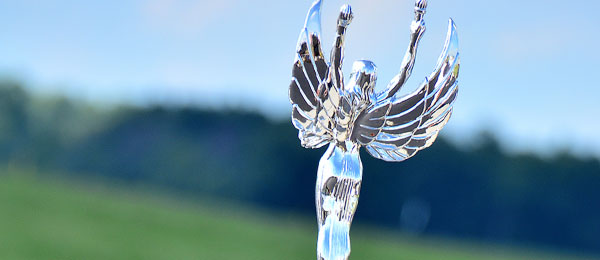
Celebrating 90 years of competition Event coverage As seen in the November 2016 issue of Model Aviation.
The 2016 Nats celebrated 90 years of competition, and ran from June 24 through August 4. The Outdoor Nats events were held at the International Aeromodeling Center (IAC) at AMA Headquarters in Muncie, Indiana. The Indoor Nats took place at the Rantoul National Aviation Center in Rantoul, Illinois. Although the Nats is certainly a competition, it is also a gathering of an extended aeromodeling family that provides attendees the opportunity to share and to learn more about the disciplines in which they choose to participate. In what follows, presented in the order in which the events took place, our 2016 NatsNews authors share their thoughts and insight into this special anniversary year of the Nats. You can learn more about the Nats, and even read this year's issues of NatsNews, at http://www.modelaircraft.org/nats. —Jay Smith [email protected]
Where does all that Nats swag come from?
AMA Custom Products brands the Nats.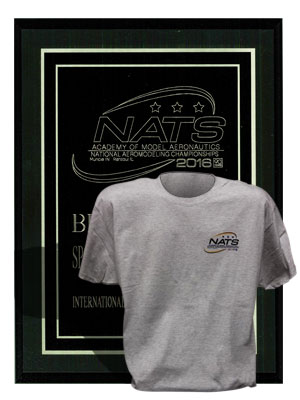 If you're at the Nats, you can't help but notice the event's branding. From pilot awards, to souvenir shirts, and even sponsorship and directional banners, the Nats brand takes over AMA Headquarters for six weeks out of the year.
The dedicated team behind AMA Custom Products (www.modelaircraft.org/products) works throughout the year creating awards and promotional materials such as T-shirts, sweatshirts, hats, and signage for AMA clubs, just like yours, across the country providing the attention to detail and knowledge of the subject matter that only AMA can.
When the Nats come around each year, that team kicks into overdrive to produce nearly 700 awards, shirts for event officials and our retail store, and signage for the entire flying site.
So that well-worn event T-shirt from a memorable weekend, the plaque you won during your best-ever contest performance, or the banner on the fence at your flying site—might have been made by your friends at AMA Headquarters in Muncie, Indiana!
If you're at the Nats, you can't help but notice the event's branding. From pilot awards, to souvenir shirts, and even sponsorship and directional banners, the Nats brand takes over AMA Headquarters for six weeks out of the year.
The dedicated team behind AMA Custom Products (www.modelaircraft.org/products) works throughout the year creating awards and promotional materials such as T-shirts, sweatshirts, hats, and signage for AMA clubs, just like yours, across the country providing the attention to detail and knowledge of the subject matter that only AMA can.
When the Nats come around each year, that team kicks into overdrive to produce nearly 700 awards, shirts for event officials and our retail store, and signage for the entire flying site.
So that well-worn event T-shirt from a memorable weekend, the plaque you won during your best-ever contest performance, or the banner on the fence at your flying site—might have been made by your friends at AMA Headquarters in Muncie, Indiana!
Jump to your favorite event!
| RC Scale | RC Soaring | CL Speed |
| RC Scale Aerobatics | RC Helicopter | CL Combat |
| RC Aerobatics | CL Scale | FF Indoor |
| RC Pylon Racing | CL Aerobatics | FF Outdoor |
| RC Combat | CL Racing | Special Interest Groups |
RC Scale (Stan Alexander)
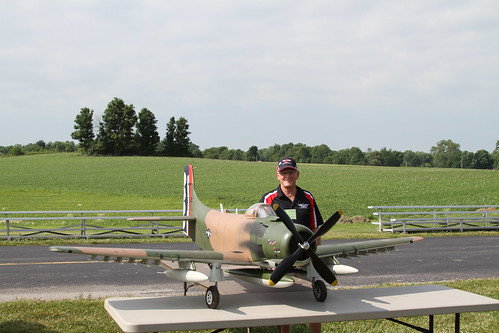
Change is the word I think about when describing this year’s Nats. A new flying site at AMA’s IAC, a new set of awards, new event director, camping quite near the flying site, and great weather all weekend are only a few of the things that come to mind. John Boyko volunteered to be this year’s RC Scale Nats event director with the edict to facilitate change, which he did with the help of many of the NASA officers and a small army of volunteers and judges. AMA outdid itself with the flying site. The grass was rolled, cut to 1/4 inch, vacuumed, then cut and rolled again. The runway was approximately 800 x 75 feet with runoffs at both ends and to the outside of the takeoff and landing area. Nobody had problems with taking off or landing on the grass, including jets, World War I and II models, or civil aircraft. There were seven classes to enter this year, including Fun Scale Novice and Expert, Sportsman Scale, Expert Scale, Team Scale, Open Scale, and Designer Scale. As in nearly all Scale competition now, Fun Scale Expert is the most popular class. A Scale National Champion was added for both RC and Control Line (CL) this year. Static judging was held on Friday, June 24, with four rounds of flying competition on Saturday and Sunday. At the Saturday night banquet, the “best of” awards were presented, as voted by the contestants. Hal Parenti won Designer Scale again this year. He promises to have a new, larger turbine-powered Ryan Fireball next year. Expert Scale saw a few added entries, with Mike Barbee and his 110-pound T-34B winning. Team Scale saw another of Mike’s entries finish first with Frank Noll flying Mike’s Flying Models Wildcat in British Navy colors. Open Scale started to pick up participants, with Will Berninger flying his T-34C to a first-place finish. Fun Scale Expert had 21 entries this year, and Terry Nitsch won with his Bob Violett Models MiG-15. In Sportsman Scale, it was great to see Mike Wartman take first place with a highly modified Top Flite P-47 that he built. In Fun Scale Novice, first-time Nats competitor Johnny Hunt, from Texas, took first place with another P-47. It was a great time at this year’s Nats, with friends, good weather, and a renewed program that speaks for everyone in AMA and NASA. Join us next year! Back to top
CL Scale (Fred Cronenwett)

The 2016 CL Scale Nats had great weather this year. The CL event, also organized by NASA, took place June 23-26 instead of in July as is customary. In 1/2A Scale, static scores came in anywhere from 50 to 76 points, with Richard Schneider earning the top static award and taking first place. Roger Wildman and Allen Goff each flew a Brewster Buffalo built from the same plans. Roger took second and Allen placed third. David Betz attended his first Nats, flying a scratch-built Pawnee that took fifth place. David also won the raffle prize of a 1/2A kit and engine. Fun Scale can be very competitive. Only a possible 10 static points can be awarded, so the difference in static points, ranging from 5.75 to a perfect 10, made a difference. Mike McHenry flew his P-39 with two flights that scored 94.5 points and higher to take first place. There was only a four-point difference between first and third. Joe Gilbert flew a B-17, built by Ed Mason, to a second-place win, and Ed flew his DC-6 to third. Sport Scale was won by Richard Schneider flying his Tiger Moth. The aircraft also took the Top Static award. The overall point spread in Sport Scale was larger than in other events, but the battle for third and fourth place went into Sunday. Both Robert Storick and Charlie Bauer flew their models on Sunday to improve their flight scores, and Robert edged past Charlie’s Islander by 0.7 point to finish in third. I returned with my 96-inch wingspan B-29 for Profile Scale and took first place with 185.15 points. Richard took second with his Cassutt racing aircraft, and Charlie Bauer took third with his de Havilland D.H.88. In Authentic Scale, everyone was excited to see Mike McCarthy’s Call-Air A-9 crop duster. Complete with a detailed cockpit, this model looked awesome and earned the high static award with 98.05 points and took first place. Mike had some trouble on his first flight and asked me to fly the second flight as a proxy pilot. The CL Scale rules allow for proxy pilots to fly the model for the builder in a situation where age or health problems could be an issue. Allen Goff placed second with his Ryan STA and Ed Mason took third with his C-124. There was one injury that required a trip to the emergency room. Frank Beatty cut a finger on a propeller while trying to adjust the needle valve. Frank wished he had kept his leather glove on as he normally does. We had a first-aid kit and kept the bleeding under control until Frank got to the hospital. Allen Goff was this year’s event director. Bob Heywood will take over the duties next year. Allen would like to thank all of the judges and tabulators who made the contest a success. Back to top
RC Scale Aerobatics (Tom Reifsnyder)
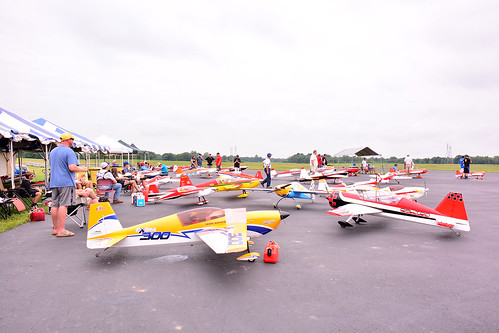
Another IMAC Nats is in the books and this one did not disappoint! Some classes remained status quo and others had some big movers. In Sportsman, Kobe Cantin dominated the class to win his first National Championship. Kobe graciously accepted the trophy, noting that Sam Pankratz was equally deserving of this award. Congratulations to William Wilson on his third-place finish. In Intermediate, Joseph Thibodeau held off a hard-charging Carlos Bonachea to win his first National Championship. David Herron rounded out the top three. In Advanced, Evan Turner and Ben Jenkins traded rounds and fought hard, with Ben coming out on top and Evan finishing second. Mitch Johnson, flying a borrowed airplane because he lost his primary aircraft, was able to make the podium in third. Last, but certainly not least, the Unlimited Class did not disappoint. Kurt Koelling and David Moser scrapped it out all week and the finals were no different. In the end, David was able to take his first IMAC Unlimited National Championship by a margin of approximately 30 points. That is close! Will Berninger rounded out the top three. The big mover of the day was Kal Reifsnyder. Kal finished third for the day, which propelled him from sixth to fourth overall in Unlimited. As always, Freestyle did not disappoint. Nine competitors flew their wings off to entertain the crowd. It was clear that these pilots were ready to unwind after the long grind of this IMAC contest. Judges were chosen from the competing regions and these people had a front row seat. An impromptu dance crew from the Clover Creek group even put on a show during Sam Pankrantz’s flight. Tyler McCormack won his second consecutive Freestyle Championship, with David Moser finishing second and Kal Reifsnyder finishing third. Congratulations to the Southeast region for winning the regional points award. The three pilots who made up the team were Ben Jenkins, David Moser, and Kobe Cantin. Finally, it was time for the Bennett Cup Award. This award is for the pilot whose raw scores are closest to perfection—no throw-out scores and no drops. For the past six years, Kurt Koelling has been the recipient of this award, which is a run unmatched by any other Bennett Cup recipient. When Kurt came to the podium to present the Bennett Cup, everyone realized there would be a new name engraved on the cup. Congratulations to David Moser for winning the 2016 Bennett Cup. It is clear that David and Kurt have great respect for each other and that this battle is not over. I look forward to seeing everyone again in 2017! Back to top
RC Aerobatics (Jim Quinn)
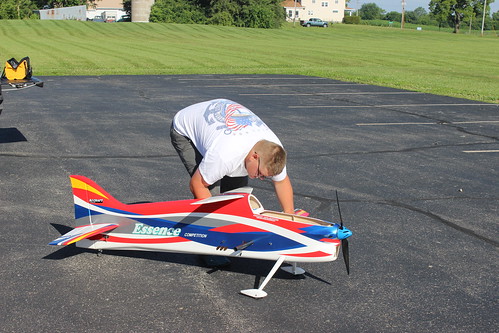
Celebrating 90 years of national competition and 20 years at AMA’s IAC, the airplanes and the piloting skills dazzle us all. What would those early model aviation pioneers think of us today? What would they think of maneuvers such as the Top Hat and Humpty Bump, or the Goldfish, and Eye Catcher? Our airplanes weigh less, but are bigger, more capable, and more reliable than those of our predecessors. Why do we keep coming back? Certainly it is for the competition. Our top pilots keep pushing each other to higher and higher performance levels. That is for sure. Even more so, however, is the camaraderie and friendship that the pilots enjoy. Each pilot has a personal goal, but for most that is not to be a national champion in his/her class. Each pilot is interested to see how he/she places with the other pilots from across the country and even among international competitors. Our Nats are open to pilots worldwide. In 2016, the airplanes themselves could be the stars. Technological advances in design, construction, and electronics boggle the mind. The level of piloting skills in all classes is impressive to say the least. This year was a team selection year for the 2017 World Championship in France. The USA, as a team and individually, has made us proud year after year. This team will have a returning Junior world champion, Joseph Szczur. Andrew Jesky will be the team captain with Jason Shulman and Brett Wickizer rounding out the team. Other national champions were Chris Odom in Masters, Chuck Edwards in Advanced, and Hunter Jones in Intermediate; however, each pilot is a champion just for participating! Congratulations to each of you. We saw many firsts at the 2016 RC Aerobatics Nats. Several new airplanes graced the flightlines. Jason Shulman’s Epic was a newly minted one-of-a-kind model, although several other Epics were there as well. Brett Wickizer flew Bryan Hebert’s latest: a Verrari. There were many returning favorites, such as the Proteus and the Allure. Electric power dominated the Nats this year, but several YS engines remain perennial favorites of some of the best pilots. The newest innovation this year, however, came from scoring. The Electronic Scribe is the collaboration of Peter Vogel and Scott Smith. Holding a game controller, the judge presses a trigger to hear each maneuver in an ear piece and another button to deduct half or whole points when a deviation is observed. This system was used exclusively at Site 4 for the Intermediate and Advanced pilots. It was also used on Thursday at Site 3 for the Masters finals. Mark Atwood, the World Championship team manager, said, “You will fear it, use it, and love it.” The Electronic Scribe allows a judge to keep his/her eyes on the airplane 100% of the time. Each maneuver is clearly announced, downgrades are automatically recorded, and the final score immediately tabulated as the pilot’s landing score is recorded. Thanks go out to two championship-caliber teams: the AMA and NSRCA. Together they made a week of fun, friendship, and competition flow seamlessly. Flying at our Nats pays dividends far beyond the actual place a pilot finishes. Start planning to attend the 2017 event today! Back to top
RC Pylon Racing (Santiago Panzardi)
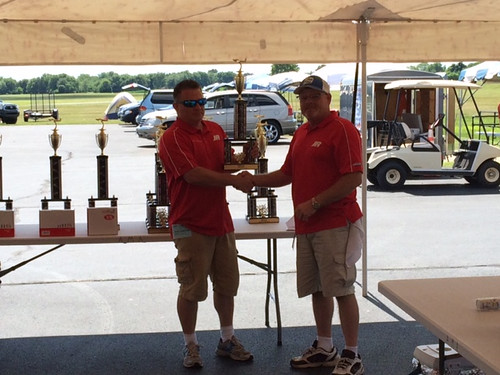
Once a year, nearly 100 pilots make the pilgrimage to an RC Pylon mecca, Site 3 of the IAC for a week of some of the hottest, fastest, and most-contested racing you will find anywhere: the Pylon Racing Nats. Most of the participants are veterans in this discipline that is organized by the NMPRA. With that comes experience, wisdom, and significant skills, but also longtime friendships among competitors. These Nats featured six events in eight days (July 15-22), the most ever. This was the first year for warbird competition at the Nats. More than 30 contestants entered this event based on semiscale warbirds with three Reno-like speed brackets—Bronze, Silver, and Gold—with the last one being the fastest with no breakout times. The course is raced from the side around two pylons, and incorporates a flying start. Richard Verano won Gold Class, Robert Holik won Silver, and Robert Hietkamp won the Bronze Class. Club 40, another form of from-the-side, two-pole racing using sport airplanes, followed on Saturday with roughly 25 participants. Traditional three-pole racing began on Sunday with AMA 424 Quickie racing. Non-composite-wing Q-500 models race with stock sport engines and stock APC 9 x 6 propellers, reaching more than 115 mph. Ken Van Tuyl bested all other contestants to become the 2016 AMA 424 Champion, and Daniel Troup was best Junior. Electric Formula 1 (EF1) started with rain that caused a two-hour delay for the 40 anxious pilots. After five or six rounds of racing, Mark Parker was crowned the winner, followed by Dan Kane, second; Dennis Cranfill, third and Fast Time; Duane Gall, fourth; and Tim Sparks, fifth. New to this year’s EF1 event was the Best of Show award, inspired by the former Formula 1 Racing class. Danny Kane was the winner with a gorgeous Kazi that resembled one of the last models built by Jim Shinohara. The premier Quickie event, AMA 426, had a fantastic turnout of 71 pilots who were eager to try their racers and their luck. Better known as Super Sport Quickie, AMA 426 started on Tuesday with the traditional two-matrix format that allowed more-thorough competition among all of the contestants. From each matrix, 14 pilots qualified to make up the 28 going into the finals, through eight rounds of preliminaries. An additional five rounds are flown by the best of the best to declare a champion. Richard Verano, who’s been away from the Nats many years, is considered a legend, having won countless national titles and a World Championship. Richard is back, and although he had to fight harder than ever, he took the Q-500 title once again. The final order after the flyoffs was: Richard Verano, first; Mark Parker, second; Marcus Blanchard, third and Fast Time; Roy Andrassy, fourth; Robert Vess, fifth; Mike Langlois, sixth; Ray Brown, seventh; Dub Jett, eighth; Duane Hulen, ninth; and Doug Killebrew, 10th. The fastest event, AMA 422 Q-40, takes the stage the last two days. These models run .40 cubic-inch engines turning more than 27,000 rpm, reaching nearly 190 mph on the course. Q-40 also follows a two-day, two-matrix format to select the top 28 for the finals. The top qualifiers in each matrix were Travis Flynn and Terry Frazer, respectively. After the five-round finals and three flyoffs, the top 10 were Dan Coe, 10th; Michael Masi, ninth; Dan Kane, eighth; John McDermott, seventh; Bryan Blanchard, sixth; Terry Frazer, fifth; Bill Johanson, fourth; Ray Brown, third; Craig Korsen, second; and Travis Flynn in first. “Rocket” Ray Brown was named Grand Champion by virtue of his combined placings in Q-500 and Q-40. Travis Flynn took Fast Time with a 1:00.40. Travis Flynn, one of the nicest and fastest pilots in the country, has been racing for more than 20 years. He is also recognized as one of the best callers in the sport, having been part of the US FAI team many times as a caller and a pilot. He has helped others win national and world titles, but he has never won the Nats. Put that all aside, because Travis Flynn will now and forever own the title of 2016 Q-40 National Champion! Back to top
CL Aerobatics (Bob Hunt)

The theme for the CL Aerobatics portion of the Nats this year was heat. The weather was hot, and the flying was even hotter. It seems that each year the level of flying proficiency gets kicked up a notch. The CL Aerobatics (Stunt) week, organized by PAMPA, kicked off with the Beginner and Intermediate events on Sunday, July 17, and it was here that the next day’s top competitors began their trek up the ladder. The Beginner and Intermediate events took place on the well-groomed grass practice circles, and everyone who flew there was appreciative of the AMA grounds crew for its efforts in preparing that site. On Monday, the Appearance Point judging for the Advanced and Open Class events took place at the Oneighty building. While the airplanes were being evaluated for workmanship and finish, the pilots’ meeting was conducted in an adjacent room. The pilots had a difficult time concentrating on event directors Denny Adamisin and Curt Nixon’s instructions because they were wondering (and worrying) about how many “pretty” points their airplanes would receive. To see so many gorgeous airplanes in one room at one time is amazing. On Tuesday, the Old-Time Stunt and Classic Stunt events were contested on the L-Pad. Old-Time Stunt models had to have been designed before December 31, 1952, and the Classic models had to be designed, built, or flown before December 31, 1969. Many of the competitors researched dutifully to find models that were off the beaten path, and it is fun to watch these great old designs take to the air once more. Things got serious on Wednesday of Nats week for the Advanced and Open fliers because this marked the beginning of the four qualifying rounds on the L-Pad. The Open fliers were divided into four groups, and the Advanced fliers into three groups. Each contestant flew two flights per day for two days, with the highest score on each day counting toward the fliers’ qualifying total. Five Open fliers were selected from each of the four circles to make up a 20-pilot finals on Friday. Nine Advanced fliers were chosen for the finals. The Open field was split onto two circles on the L-Pad on Friday, and each pilot made one flight on each circle, with the scores from each flight added for a final placing. There are no throwaway flights in the finals. It was supremely important to put in two outstanding, error-free flights to advance to the Top 5 Flyoff on Saturday. In Advanced, the flights on Friday determined the Nats champion for that event, and this year it was Mike Waldron. On Saturday, the top five pilots in Open flew three rounds, with the highest two scores counting. When the dust had cleared, David Fitzgerald had captured his ninth Open Nats crown! The Junior and Senior events are also contested on Saturday, and the winners of those events participate in the Walker Trophy Flyoff at the end of the contest. This year’s Junior champion is Ben Mills, and the Senior champion is Samantha Hines. David won the Walker Trophy Flyoff and brought to an end one very hot Nats! Back to top
CL Racing (Melvin Schuette)

It seems that a least one day during the week of the CL Nats, it rains. Held under the auspices of the NCLRA, CL Racing started on Monday, July 18, and we awoke to lightning, thunder, and rain. Luckily the rain ended early, and between people working to remove the water from the circle and the sun coming out, we were able to get things started with only an hour or so delay. In 2015, Mark Knight came to the Nats for the first time. He spent the entire week timing and counting laps. Mark enjoyed himself enough that not only did he come back, but he also brought his son, Andrew, with him. They entered a couple of the events. We welcomed back the team of Bob Whitney and Jason Allen. Both Bob and Jason have competed at a number of past Nats and have represented the US at F2C World Championships in Team Racing. Five years ago, Jason took some time off from modeling to get a college degree and to get settled into a new job. We look forward to seeing both of them at future Nats and in world competition. CL Racing always starts with F2C Team Race, which is the CL Racing event flown at the World Championships. The 2016 CL World Championships were held in Australia in May, so some of the competitors who would have normally been at the Nats were not able to make it this year. Team Race is the most complicated and expensive of all of the CL Racing events. The cost of a competitive airplane/engine combination is well above $2,000 and you need at least two of them. At the other end of the spectrum is Class I Mouse. The event requires the use of a .049 reed-valve engine with an integral tank. The preferred engine is one made from different parts from various versions of the Cox reed-valve engine. The hardest part is finding an engine that is fast enough and still gets enough laps out of a tank of fuel. This event is one of the most popular and competitive events at the CL Racing Nats and at most local CL Racing contests. Another popular event is Sport Goodyear. Sport Goodyear uses semiscale profile airplanes with .15-size engines and 1-ounce fuel tanks. There are different versions of this event flown across the country, but for the last two years we have used the Dallas, Texas, rules at the Nats. In 2017, we will hold a 500-lap Sport Goodyear race. This year, as the event director, I picked up a new responsibility. I am not certain if it was because of my leadership abilities or my culinary expertise, but the contestants looked to me to figure out where we were going for dinner every night. The easy part was that dessert meant a trip to Dairy Queen. Back to top
CL Speed (Warren Gregory)
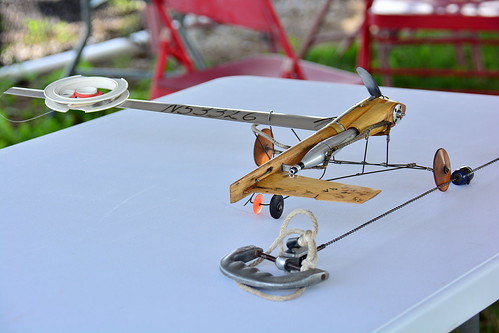
The 90th AMA CL Speed competition had 19 registered entrants. We had competitors from Ohio, Michigan, Pennsylvania, Illinois, Missouri, Iowa, Southern California, Texas, Idaho, and Indiana. For the first time in several years, a Junior competitor, Ivan Valishev, participated in two events. Congratulations to Ivan, who placed third in the F2A Junior division at the World Championships in Perth, Australia. He was entered in F2A Speed and 1/2A Profile Proto. We welcomed back to the Nats NASS Vice President Howard Doering, who traveled from Southern California to the farmlands of Indiana to compete. We also welcome back Charlie Serie who, at 83 years young, told me he wanted to see if he could make his Sport Jet “go” again. Several participants competed with new models this year. The VanSants, Glen and his son, James, have a new 1/2A Speed model, a Nelson-powered, piped B Speed model, and a new F2A model. Bill Hughes also has a new B Speed model, powered by a piped OPS engine, and a new F2A Speed carbon-fiber winged speedster. I brought a new Perky, and Texan Patrick Hemple flew a new Fast Jet. I sincerely thank John Moll, for graciously agreeing to be the event director again this year. Back to top
CL Combat (Phil Cartier)

This turned out to be a good year for Combat at the Nats. Entry numbers were the same or better in all events. Last year, following directly on the team trials, there were 29 entries with three dropouts in F2D. Even with no team trials to help pump up the entries, this year saw the same number of entries. There were roughly 175 cuts in F2D. F2D Fast on Monday had 15, nearly the same as last year. Speed Limit Combat had a record 20 entries, High Performance 1/2A had a record 12, and AMA Fast on Thursday had 10—the highest numbers in at least the last 10 years. It was one of the best showings in many years. In F2D, I think this was the first time that the winner, Igor Dementiev, had a clean record, with no losses in eight flights. For the first time in years and years of Nats, Chuck Rudner won a first place in 1/2A Combat, and as a bonus, he placed second in Speed Limit, and third in Fast Combat. Ron Colombo won Fast Combat, his favorite event, for the third straight year. F2D was a long affair with roughly 85 matches during two days. When the rain started shortly after the eighth round on Sunday, the event director and the remaining fliers agreed to call it quits and skip the last five or six matches. Igor Dementiev handily won first with eight wins. A coin toss put Vitaly Kochunts in second, and Alex Prokofiev in third. Mike Willcox ended up in fourth and Greg Wornell in fifth. Rylan Ritch managed a couple of wins in the first two rounds and was awarded the Best Junior trophy. F2D Fast Combat is fun! F2D-legal airplanes meeting the rules from 2008 (8mm mufflers) and later (6mm mufflers) cleared the air on Monday. A larger muffler doesn’t offer much, if any, advantage compared with a 6mm muffler. The newer motors and propellers run much the same, so the wins are at the handle and in the hands of the pit crew. There were a fair number of kills to win a match. The 15 fliers had 15 matches to fly, so many of the matches were short, which moved things along. Using two circles, the judges could switch to the next match as fast as they could tote up the score. Toward the end, the fliers were starting to drag because there were few dedicated pitmen. In the end, Neil Simpson won, Jim Ehlen was second, Brian Stas third, and Bill Maywald placed fourth. Speed Limit Combat on Thursday tames flight down to less than 75 mph and eliminates the kill. Cutting the string is just another cut, which can bring out a lot of difference of opinion in after-hours conversation. A big advantage is less equipment. Old F2D airplanes and most foam models are strong enough that most crashes often result in no damage or only minor repairs. Any nonfatal damage can usually be patched well enough to fly in an hour or so. The 20 fliers flew the same double-elimination first round in approximately 15 matches. Rylan Ritch was the best in the Junior category. Finishing first was Bill Maywald; Chuck Rudner was second; third was Ed Bryzs; and in fourth place was Greg Hill, There were 12 entries in 1/2A Combat and the action was fast and furious. The shorter lines make up for the lower speed, and make for a dizzying effect. There were a number of midairs and crashes. The little airplanes aren’t as strong as the bigger ones. The foam airplanes held up better with little, if any, loss in performance. Finishing first was Chuck Rudner; in second place was Greg Hill; Brian Stas placed third; and Rod Christie finished fourth. Fast Combat was flown on Thursday, and it was fast for the nine fliers. In addition to the speed, these airplanes pull hard—something like 15 or 20 pounds. It gives the pilot a real workout. The flying was great with few up-and-down matches, a number of cuts, and the final match. It ended with first going to Ron Colombo; second to Don Jensen; and third place to Chuck Rudner. I want to thank MACA and the people who ran the CL Combat events. Event director Dave Edwards did cut judging, along with Tom Reuben King and Bob Nelson. Arlene Pyles ran the matching and scoreboard with some volunteer help. Bob Mears helped as an alternate circle marshal and cut counter. He and Arlene, along with Jan and Andy Mears, came up with the “flow-through” processing that streamlined airplane checks and the pull test. They also built the simplified, fixed pull testers. Chris Gay spent two full days in the sun as circle marshal for F2D and did an excellent job. Brenda Schuette was CL liaison with the AMA and coordinated water, mowing, and trophies. Countless others pitched in to help with cut counting, pull tests, circle marshal duties, getting airplanes on the circle, and pitting if necessary. Helpers kept things moving the whole week and deserve some thanks and recognition. Back to top
RC Combat (Don Grissom)
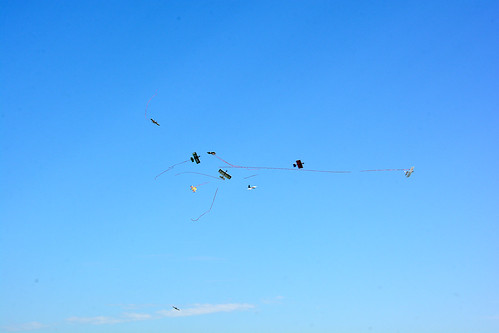
One of the most exciting five minutes of flight at the RCCA Nats can be found at the RC Combat site every year. Each airplane launches with a 30-foot crepe paper streamer. As many as 10 airplanes are in the air at one time, maneuvering around each other, trying to cut opponents’ streamers as well as safeguard their own. RC Combat airplanes, unlike most models, are generally homebuilt or built from basic kits. Most are made from material you can purchase at a local hardware store. This makes them easy to set up, but they are durable because they have to withstand the midair collisions and crashes that happen during each flight. During RC Combat week at the Nats, we fly five types of Combat, including 2948 Scale, Slow Survivable Combat, Open, Limited B, and Gnat. This year, 16 pilots signed up for the events. Some were newcomers and many have been coming for years. Among the winners this year was Eric Gilkey, who placed first in three events—Gnat, Limited B, and 2948. These happened to be the only events he participated in because he missed the first two days of Combat! Andy Runte won SSC Combat, and Heath Bartel placed first in Limited B. If you really want to see some action and crashes, then there is no better place to visit than RC Combat during the Nats. Back to top
Indoor FF (Mike Kirda)

This year’s Indoor Free Flight (FF) Nats, July 19-24, was in a “new” location—Hangar 3 located on the now-shuttered Chanute Air Force Base in Rantoul, Illinois. Several Category 2 records were set there 30 years ago. I believe one still stands, so we knew going in that it was a records-capable site. This year’s Indoor Nats, organized by the NFFS, ran concurrent with the Outdoor Nats, with the hope that we could boost attendance. We did gain a few attendees, particularly on the glider side, but few Scale modelers attended. The weather was forecast to be hot and humid with light wind, with the temperatures peaking in the mid-90s. Unfortunately, it was quite accurate, with humidity inside the hangar between 80% and 99%. It was brutal, and everyone looked as though they had just crawled out of the shower. The building has a pretty predictable pattern to it. With any significant directional wind outside, there was drift in that general direction. The air temperature is remarkably homogenous, with little difference between the ceiling and the floor and almost no turbulence. In the morning, a convection current caused by sunlight along the hangar doors led to drift near the ceiling away from the doors. A few feet below this, there was a less-intense return current. You could often see a model launched near the doors climb up to the ceiling, then drift nearly across the hangar, lose a few feet, and then come most of the way back before landing. Models with a tight enough circle could take advantage of this morning lift. The first days were the light events. Amazingly, we had 12 F1D fliers registered, and this was without regular fliers John Kagan, Brett Sanborn, and Kang Lee. The first record was set in 35cm/F1R by Joshua Finn, who launched into lift near the hangar door and had to steer more than a dozen times to stay away from the door. F1D fliers had a harder time in the heat and humidity. Many had issues with their 5/99 rubber, which is known to be fragile in the heat. Even 3/02 rubber, which is known to be less frail, had problems. Throughout the course of two days, the competition was intense with times lower than expected. This was likely because of humidity. Higher humidity acts like an increase in altitude. The next record to fall was in Autogyro, again by Joshua Finn. The third record to fall was in Senior A-6, by a young flier who came from Virginia. His score was better than many adult fliers. Limited Pennyplane was hard fought this year, with new faces. Bill Gowen has done more than 12 minutes in Rantoul, but with the humidity, times were well down in the mid-10-minute range. Stan Buddenbohm attended his first Indoor Nats in many years. Kurt Krempetz, Bill Gowen, Jan Langelius, and Rob Romash were all in the mix. There were many great flights. Two of the highlights from the competition were the P-18 build-and-fly event and the Coconut Mass Launch. More than 30 people signed up for P-18, and the mass launch that followed was spectacular, with a winning time of 2:10. The Coconut Mass Launch ended with only 12 seconds separating first and second place. Watching these models fly so slowly around is mesmerizing. Back to top
RC Soaring (Larry Jolly)
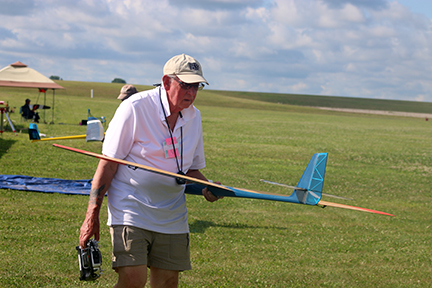
This year the RC Soaring Nats competition was held at the IAC beginning Saturday, July 23, and wrapping up on Saturday, July 30. This weeklong event has become affectionately known as “Glider Camp.” Glider Camp is organized and run by the LSF. There was a new board inducted into leadership for the LSF in January. Larry Jolly is the president; Peter Goldsmith is vice president; James McCarthy is treasurer; and Skye Malcom is secretary. The new board wanted to improve the Nats and worked very hard to improve customer relations for our Nats attendees. We changed some things, including the ability to sign up a designated timer, and added the option to drop the lowest score for all events. We slowed the pace and added some after-hours special events that we hoped would foster inclusiveness and a more fun atmosphere, while still maintaining a high-caliber Soaring event worthy of a national championship. I am proud of the 2016 LSF board members, and their hard work. Things came together in one great Soaring contest that will be long remembered. Thank you for a job well done! Among the special events was the Whipit DLG contest, where the winner was awarded a complete RTF Whipit DLG glider with a Spektrum transmitter. Thank you to Peter and the Team Horizon Hobby people who assembled and test-flew each of the six UMX Whipit models. The LSF also sponsored a pulled pork barbecue dinner. There was no charge, and all of the contestants were invited. The pulled pork was cooked to perfection by well-known chef, John Diniz, who drove up just to prepare our feast. Thanks, John! I am hoping we can get you to come back and help the LSF again next year. The last special event was the Aero Tow Pizza Night. Several beautiful Scale gliders showed up with tugs and those who were interested were offered the opportunity to try out the new Horizon ASW 20. Those who just wanted to watch were offered all of the pizza and soft drinks they could get down. I had a wonderful time both flying the ASW and enjoying some great pizza. In addition to the LSF board of directors, many volunteers behind the scenes made sure that the Soaring Nats ran smoothly. The event could not happen if these hard workers did not show up and work hard! I want to thank the following individuals: Cross Country was organized and run by Tom Broeski and Chuck Pinnel; Two-Meter was run by Scott Harper; F3K was run by Tom Siler; RES and Nostalgia were run by James McCarthy; Unlimited was run by Skye Malcom; F3J was run by Bill Christian; and Altitude Limited Electric Soaring (ALES) was run by Wally Adasczik. Running the flightline were Johnny Berlin, Wally Adasczik, Peter Goldsmith, and a number of LSF volunteers who kept things moving the entire week. Robin Meeks kept scoring on schedule and results updated in a timely manner. These volunteers deserve a huge hand for their efforts that made the 2016 Nats such a great success. Thank you. You did a fantastic job! So with all that work, Glider Camp was destined to be a major success. We had eight glorious days of RC Soaring competition. Everyone had a great time; we got in some very competitive flying, and had a fun experience. Mother Nature even cooperated and we had some of the nicest weather that most of us could remember. We will soon be planning the 2017 Soaring Nats and I hope that we can do an even better job next year. If you have ideas that could help make Glider Camp better, please contact the LSF board through the website. If you would like to volunteer to help, we can always use some extra hands. On behalf of the LSF, I would like to thank all of the excellent Soaring pilots who attended and made this such a wonderful time. I promise we will try to do even better and want you to know you will be missed if you can’t make next year’s Nats. Plan on coming back and bring a friend with you! Hope to see you next year! Back to top
Outdoor FF (Bill Kuhl)
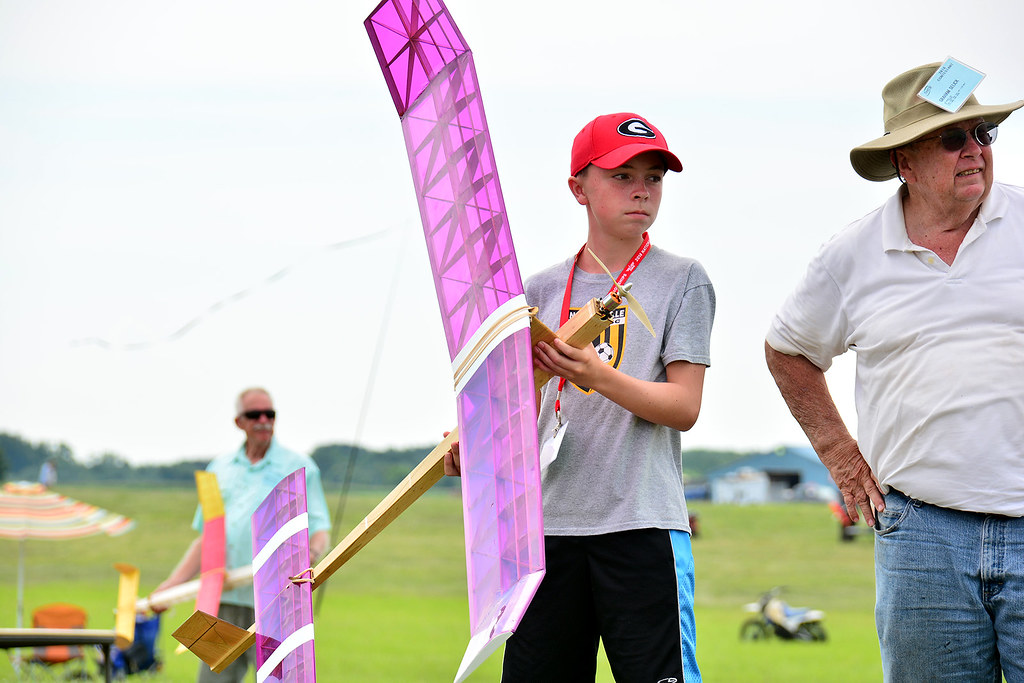
This was my first Nats as a competitor and only the second Nats I have attended. The first was in 1973 in Oshkosh, Wisconsin. For the longest time, I wanted to see the AMA facility in Muncie, especially the museum, but I also wanted to fly from a large flying site with the top competitors in the country. I have more competition experience in RC Sailplanes, but I thought the NFFS-sponsored FF competition would be more interesting because of the variety of events. With a couple of my online FF friends persuading me to come, and an experienced FF friend from Minnesota offering to take me along, this was the year I had to go. After arriving on Saturday evening, we began test-flying on Sunday, the day before the actual competition that started on Monday. Sunday afternoon was probably about the windiest it was all week, and that wasn’t bad because the weather all week was amazingly good for flying. I was really interested in seeing all of the electric FF activity because I was adjusting a model for the popular E36 event. Several people went out of their way to help me get it flying. Some of the electrics appeared to climb about as fast as glow-powered models. Writing the NatsNews, the daily newsletter that covered the Nats, gave me good reason to talk to a number of fliers in different events. One of my first interviews was with Ruth Bane, who flew a ducted-fan, glow-engine-powered airplane that went up like a rocket every time; I took her picture in the award ceremonies for winning first place. Other memorable events were the FAI events, with screaming glow-powered airplanes going straight up and high-tech rubber-powered models that climbed straight up as well. At the same time, there were spark-ignition gas-powered models flying and Jetex models. Rise-off-water and Payload events were on my agenda to check out. The nice way John Diebolt’s rubber-powered model took off from the water and flew has to be seen to be believed. Equally amazing were the rubber-powered Scale models flown by the Flying Aces Club. It was great to see a number of Junior and young adult competitors; they did well and appeared to enjoy themselves. One young man, Zach Seymour, flew a large ignition-powered model wearing a hard hat that corresponded to the period, and later had a huge string of maxes with a glow-powered airplane. One day it appeared as though it would rain, and I went through the National Model Aviation Museum. It was absolutely amazing—the closest experience to time travel I have had in my life. Back to top
RC Helicopter (Mike Unger)
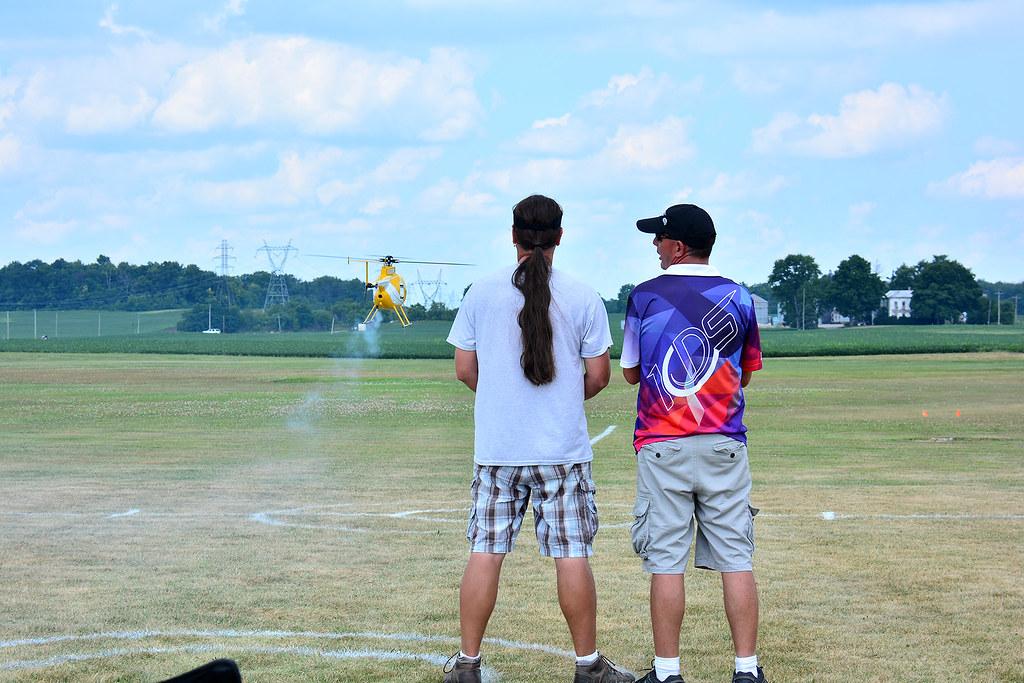
If you missed the IRCHA Helicopter Nats this year, you missed a lot. In addition to the usual AMA Classes 1, 2, and 3, the F3C and newly formed F3N competitions were underway. FAI classes are always hotly contested, but this year was even more intense. Those who would represent the US in the 2017 FAI F3 World Championships for Model Helicopters in Poland next spring would be decided at the Nats. The Nats started on Sunday night with a pilots’ meeting led by Craig Bradley, the contest director. The turnout was good this year. Among the 22 competitors were two new ones in Class 1 (Sportsman). The plan was to get in seven rounds of flying during the three days. With a good turnout and the addition of the new F3N Class, this would be a challenge for Craig and his crew. Of course, the buzz this year was about the new F3N Class. Basically, this class is precision flying like the others, but all of the maneuvers are 3-D. In addition to being judged on how well each pilot does a series of maneuvers, they also do rounds of freestyle to music. In those competitions, they are judged not only on the maneuvers, but also on artistic quality, how well they are in sync with the music, and the overall entertainment value of their flights. When you assemble some of the best 3-D pilots in the country, all going for the win, the competition is fierce, and very entertaining to watch. Five competitors comprised the F3N Class, of whom three were chosen to represent the US in Poland. The winner came down to the wire. Nick Maxwell took the top spot over Jamie Robertson by a mere 14 points. These young men are both incredible pilots and they put on a great show with their freestyle routines. To be honest, I can’t quite understand how the judges could decide on a winner. A newcomer to the 3-D scene, Devin Hammond, rounded out the top three. The F3C Class was also hotly contested, with the same Team USA invitation going to the winners. Seven competitors fought it out, flying the newly released FAI maneuvers. The winner was again Nick Maxwell, followed by Daniel Hiatt, and Dwight Shilling. These three pilots, along with Cliff Hiatt as the alternate, will represent the US next year in the F3C Class. Class 1 finished with Bernard Shaw winning in decisive fashion, taking the win in each round he entered. Second was Vincent Drouillon competing in his first Nats, followed by Peter Bisbal rounding out the final podium position. The Class 2 winner was last year’s Class 1 winner, Robert Montee, followed by Eaton Bryce. The Class 3 winner was Dennis Purduski followed by Don Miller. Congratulations to all of the competitors! As in years past, the competition didn’t end with the flying. It was then time for the Dwight Shilling Food Challenge. This is a crazy contest that Tim Diperi and other F3C pilots came up with many years ago. The challenge is to find a food that Dwight won’t eat or would not eat again. Rules are simple: the “food” must be suitable for human consumption and have a bar code on the label. Other than that, anything goes. Entries this year were Crisp Black Fungus (it actually said that on the label), fish spears in milk juice, some kind of spicy concoction, and some rolls of seaweed. To everyone’s shock, Dwight ate everything and then in a final, unprecedented maneuver, he took some seaweed, added some Crisp Black Fungus, a fish spear, and a touch of the spicy sauce, rolled it up into a tasty wrap, and yes, ate it all! Talk about a showman. Maybe next year he will step it up and do it to music! One final note about the 2016 RC Helicopter Nats. Craig Bradley officially made this one his last after 22 years of tirelessly running the program. I have only been involved in the Nats for two years, but I can say Craig has the appreciation of not only the competitors from 2016, but from the pilots of the 22 previous years. Craig, I know I speak for everyone when I say thank you for your service! I also want to make a special call out to Craig’s wife, Karen, for putting up with him for all those years, and for doing the scoring and computer work for the last five years! Craig, you will always be welcome at the Nats. Don’t be a stranger. Next year I challenge you to come join us. You think you’re the best? The Nats is where you will find out. Back to top
Special Interest Groups
International Miniature Aerobatic Club (IMAC) RC Scale Aerobatics | www.mini-iac.comInternational Radio Controlled Helicopter Association (IRCHA) RC Helicopters | www.ircha.org
League of Silent Flight (LSF) RC Soaring | www.silentflight.org
Miniature Aircraft Combat Association (MACA) CL Combat | www.macasite.org
National Association of Scale Aeromodelers (NASA) CL and RC Scale | www.nasascale.org
National Control Line Racing Association (NCLRA) CL Racing | www.nclra.org
National Free Flight Society (NFFS) Indoor and Outdoor Free Flight www.freeflight.org
National Miniature Pylon Racing Association (NMPRA) RC Pylon Racing | www.nmpra.net
National Society of Radio Controlled Aerobatics (NSRCA) RC Aerobatics | www.nsrca.us
NaVY CARRIER SOCIETY (NCS) CL Navy Carrier | www.navycarriersociety.org
North American Speed Society (NASS) CL Speed | www.clspeed.com
Precision Aerobatics Model Pilots Association (PAMPA) CL Aerobatics | www.pampacl.org
RC Combat Association (RCCA) RC Combat | www.rccombat.com
Back to top










Add new comment